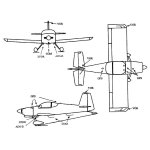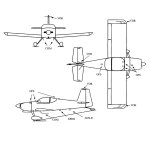I'm trying to decide where to place my RV-7 belly-mounted comm antenna. (It's a DeltaPop bent whip antenna if that makes any difference.) My current thinking is to place it with a doubler out of the exhaust (and oil mist!) flow, so off to one side (passenger), and either just aft or just forward of the main spar carry-through.
Arguments in favour of Aft placement:
1) Cable will be out of the way of feet and carpet forward of the spar.
Arguments against Aft placement:
1) Radiation will be directly under the passenger?
2) Aft belly skin is thinner than forward belly skin,
3) Cable will need to go through the spar carry-through area,
4) Cable could interfere with aileron push-rod.
Arguments in favour of Forward placement:
1) Forward belly skin is thicker than aft belly skin,
2) Less radiation for passenger?
3) Easier cable layout,
4) Cable won't interfere with aileron push-rod.
Arguments against Forward placement:
1) Cable could get damaged by feet?
2) Cable will interfere with carpet and require a hole to be made?
Obviously if the forward placement could have the cable emerge into the area forward of the spar but aft of the F-782A-R cover plate then it would be an easy choice, but my feeling is that probably isn't possible - can anyone comment on this?
Any pointers or thoughts gratefully received! Thank you.
Arguments in favour of Aft placement:
1) Cable will be out of the way of feet and carpet forward of the spar.
Arguments against Aft placement:
1) Radiation will be directly under the passenger?
2) Aft belly skin is thinner than forward belly skin,
3) Cable will need to go through the spar carry-through area,
4) Cable could interfere with aileron push-rod.
Arguments in favour of Forward placement:
1) Forward belly skin is thicker than aft belly skin,
2) Less radiation for passenger?
3) Easier cable layout,
4) Cable won't interfere with aileron push-rod.
Arguments against Forward placement:
1) Cable could get damaged by feet?
2) Cable will interfere with carpet and require a hole to be made?
Obviously if the forward placement could have the cable emerge into the area forward of the spar but aft of the F-782A-R cover plate then it would be an easy choice, but my feeling is that probably isn't possible - can anyone comment on this?
Any pointers or thoughts gratefully received! Thank you.






